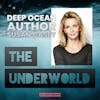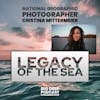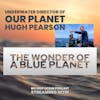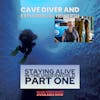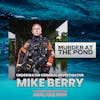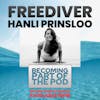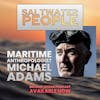The Underworld: Deep Ocean Author Susan Casey On Why It Is Vital For Humanity To Look Even Deeper

In today's episode, I speak with Susan Casey, New York Times bestselling author and journalist, whose work focuses primarily on the intersection of human beings and the ocean.
Susan started as a journalist, becoming a national magazine award winner and editor-in-chief of O Magazine, creative director at Outside Magazine, and editor-at-large for Time Magazine.
But it was her books that really caught my attention, especially her latest, The Underworld: Journeys to the Depths of the Ocean, which explores the deepest parts of the oceans through the people who journey there.
The deepest trenches of the ocean fascinate me, as I love the idea of the unknown, especially when it lies in the environment I love the most. So unsurprisingly, a thirst for understanding the unseen parts of our world's oceans often parallels the sense of deeper personal exploration, as it does with Susan.
So we spoke about a recurring dream from childhood that may have started her fascination with water, what drives human beings on the journey of the unknown, And a profound moment she had on her first dive into the depths of the oceans of our world.
Jason Elias:
Hi and welcome to the Big Deep podcast. Big Deep is a podcast about people who have a connection to the ocean, people for whom that connection is so strong it defines some aspect of their life. Over the course of this series we'll talk to all sorts of people and in each episode we'll explore the deeper meaning of that connection. Today I speak with the bestselling Deep Ocean author, whose work has taken her to some of the deepest parts of our world's oceans, and herself. Hello, this is your host, jason Elias. Welcome to the Big Deep podcast. In today's episode I speak with Susan Casey, new York Times bestselling author and journalist, whose work focuses primarily on the intersection of human beings and the ocean. Susan started as a journalist, becoming a national magazine award winner and editor-in-chief of O Magazine, creative director at Outside Magazine and editor-at-large for Time Magazine, but it was her books that really caught my attention, especially her latest, the Underworld Journeys to the Depths of the Ocean, which explores the deepest parts of the oceans through the people who journey there. The deepest trenches of the ocean fascinate me, as I love the idea of the unknown, especially when it lies in the environment. I love the most and so unsurprisingly, a thirst for understanding the unseen parts of our world's oceans often parallels the sense of deeper personal exploration, as it does with Susan, and so we spoke about a recurring dream from childhood that may have started her fascination with water what drives human beings on the journey of the unknown? And a profound moment she had on her first dive into the depths of the oceans of our world.
Susan Casey:
Hi, I'm Susan Casey. I write books about the ocean.
Jason Elias:
Yes, you do so. Susan, can you talk a bit about when you first remember your connection to the water?
Susan Casey:
Well, for me it was lakes. I grew up outside of Toronto and we had a summer cottage an hour and a half north of the city and the water is very dark and there are large fish in these lakes and I remember there were moments when I caught glimpses of northern pike and a bigger fish called a muskelunge and I was a little bit scared of the water but more than anything I wanted to see them, particularly if I could be, say, standing on the dock and looking at them in the water. So I started having this recurring dream where I was in a little boat and I was little, looking down into this really dark water and there were these very large fish just moving around. I could see them as silhouettes and when there was a fish it was like this draw and in fact I remember being completely mesmerized and I could not think or look at anything else.
Jason Elias:
It's really interesting how you had these dreams that directly paralleled where your life would lead you later with your writing. So you had this sense of connection to the water and again I love that idea of there being something. You didn't understand but still drew you onwards. And so you started as a journalist, focused a bit more on outdoor adventure, and then you wrote one of your earlier bestselling books, the Devil's Teeth, about great whites off the Feralon Islands. But I'm curious what finally drove that initial feeling of connection to the water into wanting to explore the more hidden parts of the ocean.
Susan Casey:
And my first book was about this neighborhood of great white sharks at this place called the Feralon Islands, which is 27 miles due west of the Golden Gate Bridge and I first saw it on a BBC documentary with David Haddenborough. And I saw these incredibly bang-like islands and this dark water and about nine or ten mature great white sharks around this little tiny research boat with these two scientists in it, and it was exact match for the imagery that I'd been seeing in my dreams. So I was like I have to get out there. Fast forward about a year I went to work for Time Inc and I was an editor at large and the editor of Time magazine said to me do you have anything in particular you wanna write about? I was like, yeah, I wanna go to the Feralon Islands, but there was nothing written about this place. So I ended up going out there multiple times. I spent weeks trying to live on a sailboat just to be able to hang out with these shark researchers who were rewriting the book on what we knew about Great White Sharks, and it was there that I really began to see that there was this parallel universe beneath the surface and it was so immense On any given day very large Great White Sharks would pop up. One day I saw 40 blue whales lunch feeding. There was one commercial diver and he said that he had come across a 10 foot tall anchor, like there had been all these shipwrecks out there. So it just started to percolate in my mind. There was a lot going on down there and what would you see if you went?
Jason Elias:
Yeah, I mean that idea of there being something there in a place that we love, but we don't know exactly what it is. I love that idea and for me, as a long time Buddhist, I find the ocean to be an almost direct parallel to my journey of self discovery during meditation the idea of there being a surface that most people see and even enjoy but rarely deeply explore. Having read the underworld, your book, I sense from you a more profound connection to going deep than simply the adventure of it. So what is it about the ocean that intrigues you, that drives you to see its deepest parts?
Susan Casey:
Everything about the ocean is behind a veil and in order to understand it, we have to be in it. Every time we go into the ocean, and particularly the deep ocean, you can drop down in a submersible almost seven miles to the sea floor and, with the exception of one or two very well known sites, you are in a place that nobody has ever seen before. In order to understand the Earth, we have to know her. She is 98% ocean and 95% deep ocean. 80% of the microbial life of the planet is in the ocean, mostly the deep ocean. So there is something so important about having human eyes and minds and hearts down there, because when you go down three or four miles into the ocean, you know this planet very intimately and there's a presence to it. And it is not space, because everywhere you look there's life. It's not a void, it's twinkling, glowing, highly adapted, beautiful, fascinating life. Everywhere you look, and to me, every species, down to the tiniest microbe, is this absolutely exquisite part of the whole, as are we, and no different. In the world that we live in now, the culture that we have, the set of beliefs that we operate by, it is very easy for us to look up and think, okay, we're going to rock, rock it into the sky and everything that's baked into our language is we're going to rise up. But when you start talking about going downward and inward, in modern Western culture we celebrate that less. Because heaven is up there, we think, so hell must be down there. The deepest part of the deep ocean is called the hail zone, so it's literally named after Hades the underworld. So I wanted to go downwards, because the journey inward it's a journey into darkness, it's a journey into the unknown, but it's also the journey into the life force of the planet. And the underworld is, in fact, where the treasures are.
Jason Elias:
Oh, that's beautiful and I know this isn't a drive that keeps you at a distance to write about it intellectually, because you've actually gone down to some of the deepest parts of the ocean in deep sea submersibles. Can you talk a bit about that, and why is it important for humans to actually go to those depths?
Susan Casey:
My thesis was that the deeper you went, the more astonishing it became, and I wanted to see if I was right. So in the 70s, 80s, there was a kind of a golden era of manned undersea exploration with all these different kinds of subs, and largely started to get robotic in the 90s. And now there's a renaissance because it's becoming clear that there's a place for all of it, all of these tools. We need them and there is something different to be learned by actually having humans that go into the environment. Yet it was not going to be easy, because at the bottom of the Mariana Trench you'll encounter 16,000 pounds of pressure per square inch, so that's like having 377 stacked on top of you. There are relatively few machines that can get you into the abyssal zone or deeper, which is below 3,000 meters or 10,000 feet, and they were mostly owned by nations or scientific institutions. And I really wanted to experience that maximal immersion and I got very lucky and was able to make not just one dive but two dives, and one of those two dives was into the abyssal zone. I wanted to get as close to the physical truth of this planet as I could, and that, to me, was in the ocean. It is who she is. One of my neighbors on the North Shore, maui, who was WS Merwin the poet, and we became close friends. He said you know, our saving grace is our imagination. We have to cultivate our imagination and when thinking about the deep ocean we are not using our imaginations If we don't look as closely as we can at the incredible miracle of little mystical animals that nobody's seen before everything. There is nothing that nature does that is not worthy of our closest scrutiny. So I figured that it would move me spiritually. I figured that I would have a different perspective on life and our place in it. And I was right, and I hope I brought that home in the book because that is so worth sharing.
Jason Elias:
I think you did, and there is a part of your book that actually broke my heart in a way with its beauty, and it happened on a deep submersible dive off the Bahamas, and I also know, as you explained in the book, the dive had a tremendous impact on you personally. So can you take us on a journey of what that dive was like?
Susan Casey:
So a lot of the book leads up to the dives that I make. When you go into the deep ocean you're sitting in a sphere and the sphere is really important because it's the only shape that distributes these immense pressures symmetrically. So if you crush a very strong sphere, it just gets stronger, and so most of the really deep submersibles the sphere is made of metal and you just have view ports, but they're the size of dinner plates. But if you're going to say, between 1,000 and 6,000 feet, you can sit inside a sphere that's completely crystalline plexiglass and it's like sitting inside a bubble. So you can go into the deep ocean. And the top layer of the deep ocean is known as the twilight zone. It's also called the mesopelagic zone, and there are more creatures in the twilight zone than there are in the rest of the entire ocean combined. There are trillions and even quadrillions of creatures in the twilight zone and 80% of them are bioluminescent. So it's great if you're in a crystalline bubble and not just looking throughout the viewport. So my first dive took place offshore in the Bahamas. I was on a ship called the Alusia, which is owned by an organization called Ocean Acts that takes a lot of media companies into the deep ocean. They do a lot of filming and these translucent subs are fantastic for filming because you have a 340 degree view. You're in a psychedelic aquarium. So on this day it was myself and two pilots in this sphere. You get creamed off the edge of the ship and lifted up and set in the water, and then a swimmer comes along and unhooks the lines that are connecting it to the crane and then the pilot begins to pump seawater into the ballast tanks to make the sub negatively buoyant and you start to descend and the first thing you see when you get through the service water as anybody scuba dives knows the spectrum drops away. So first you lose red light, then you lose orange, then yellow, then green, then blue and finally violet. So when you get to about 200 feet, you're really just starting to look at blue light, and there's something incredibly narcotic about the pure blue light. To me, it was alive, this color. You sit there and revel in it. You just don't see this light anywhere else on earth, and then you go through an indigo transition and then you go into the darkness. However, the blue light is still there. It percolates faintly to about 3,000 feet, but our eyes can't see it. So when we get into the dark region of the ocean and we were going to 3,300 feet, which is the bottom of the twilight zone you start to see the bioluminescence and you go past creatures and you jostle them and they light up. The majority of the world's known jellyfish species are there, all kinds of microorganisms, all the wacky little fish, some larger creatures. It's just a cosmopolis, a very colorful being. And so we did our dive. We were diving in tandem with another sub and we got down to the seafloor and they turned on the lights and I don't know what I expected, but it was limestone silt, very fine sediment. And so when they turned on the LED lights of the sub the blue light, as I mentioned, is still there it lit up like an aquamarine swimming pool, but pure, brilliant white and the beauty of it, I mean, I was just in complete euphoria the whole way. We started tooling around and we flew up and down. It looked like kind of Saharan sand dunes, but they were bright, white. After a while you have to go up, release our ballast weights and started to ascend, but not very quickly. When we got to about 700 meters, about 2,200 feet, the chief pilot, who was in my sub said OK, now the two subs are going to hold and we are going to turn every light off. We're even going to put towels over top of our control panel, so it's going to be pitch black. So the two subs are floating in complete pitch darkness and he says, ok, I'm going to count to three, and on three you open your eyes. He counted, and on two, both subs have flashed their brightest lights on and off very quickly. And on three we opened our eyes and the entire water column lit up with fireworks. That very powerful flash set off every creature as far as we could see in the water to flash back with its biolubinescence and, as I mentioned, the vast, vast majority of them can light themselves up In the deep ocean. This light is a signal. Let's communicate, communication its information, it's their means of hunting, mating, disguising themselves. There is all these different strategies. When you think of the size of the deep ocean, particularly the twilight zone and the layer beneath it which is called the midnight zone, this is the most common form of communication on Earth, this light signaling. So here we are, in the middle of this rain of fireworks. It only lasted for a few seconds, but what was incredible about it was that you got to see that you were in a matrix of life. The amount of biological activity in the water made it so incredibly viscerally clear that this is not space, this is absolutely a soup of life, and not only that we're greeting each other. So we then freaked out. And then we went up a couple hundred meters and did it again and screamed and swooned and reveled. And then we went up another hundred meters and did it again. We made a signal and they signal back. They were greeting us, we were greeting them. It was a communion and it was so magnificent. And so when we got closer to the surface and the blues started to come back, I started feeling very grief-stricken and I did not know whether I would ever have this chance again, and I equated it to falling in love and then never seeing the person again. I felt like I had finally gotten to the place that felt like home to me, and now I was never going to see it again, and I really grappled with that emotion for quite some time. I think that it was a means of going to the place that I had always dreamed of going, this aquatic realm that I knew existed, but it seemed dreamlike to me because I couldn't access it, and it made those creatures personal to me and I got to meet them.
Jason Elias:
Finally, we end every interview and every episode with a single open-ended question. We ask everyone we talk to what does the ocean mean to you?
Susan Casey:
It's life and love and it's the most beautiful reminder of that.
Jason Elias:
Thanks for listening to the Big Deep podcast. Stay tuned as we work on the next season of Big Deep with even more incredible stories of people whose lives have been transformed by our world's oceans. We really appreciate you being on this journey into the Big Deep as we explore an ocean of stories. If you like what we're doing, please make sure to subscribe wherever you listen to podcasts. Also, please find us on the socials where you can like and comment, because those subscribes, likes and comments really make a difference. For more content from our interviews in our series, photos of every guest or just to get in touch, please reach out at our website, bigdeepcom Plus. If you know someone you think we should talk to, please let us know at our Big Deep website, as we are always looking to hear more stories from interesting people who are deeply connected to our world's oceans. Thanks again for joining us.
Featured Episodes
Highlight episodes from our incredible ocean guests.























